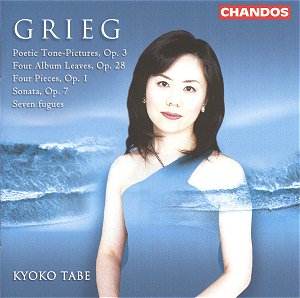The revival of interest in Grieg’s music, which has been gathering
momentum for some little time now, continues with this attractive issue
from Chandos. All the music is relatively early, from the Seven Fugues
of 1861-2, which have no opus number, to the Four Album Leaves,
which, though published in 1878, contain music from as far back as 1864.
Everything here is worth listening to, though of course
the fine sonata is the most substantial work. As you might expect, it
shows throughout the influence of, especially, Chopin and Schumann.
Grieg’s own personality shines through strongly in many places, though;
perhaps most of all in the galloping finale. Here Grieg asks a lot of
his pianist – and the piano – in terms of sheer power of tone;
indeed, you feel that the music is orchestrally conceived in many places.
Here, as elsewhere, Kyoko Tabe, the Japanese soloist, plays with great
technical assurance, and clearly relishes the wildly extravert character
of much of this piece.
The Seven Fugues are a curiosity, but they do
indicate Grieg’s excellent technique in handling a complex form such
as fugue, and the themes on which the pieces are based have an individuality
that prevents them from being mere clones of JSB. The other three sets
recorded here, op.1, op.3 and op.28, are all similar to the kind of
thing Grieg did so well in the various sets of Lyric Pieces, and
many of them are enchanting. Listen to the relaxed folk-dance rhythms
of op.3 no.5, veering between major and minor, and bringing Dvořák
to mind; or the gentle Chopinesque melancholy of op.1 no.2; or
the evocation of the distant sound of that wonderful Norwegian folk
instrument, the Hardanger fiddle, in the middle of the final number
of op.28.
Even in this music from early in his career, Grieg’s
expressive range and the fertility of his imagination come over strongly,
and Tabe is always a sensitive, responsive interpreter. I hope that
Chandos will find her the opportunity to continue her exploration of
the Grieg repertoire.
Gwyn Parry-Jones


